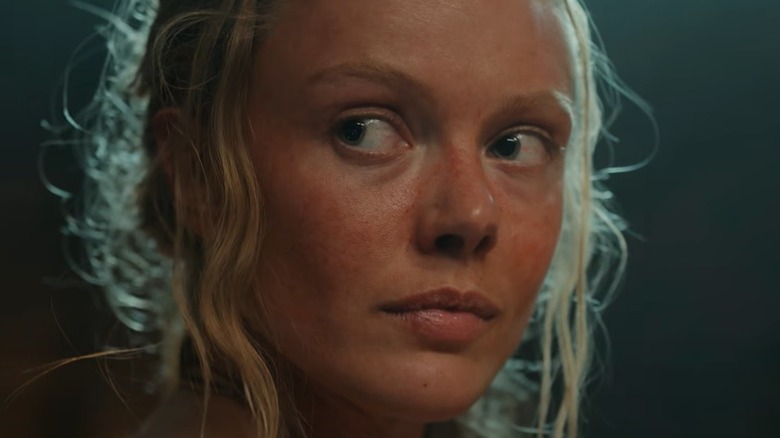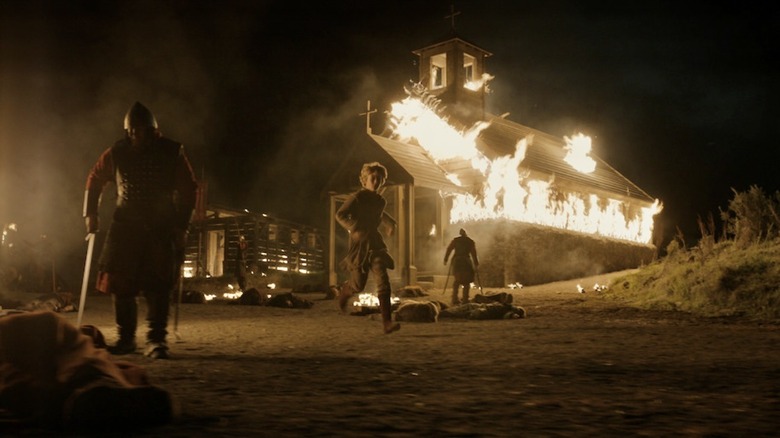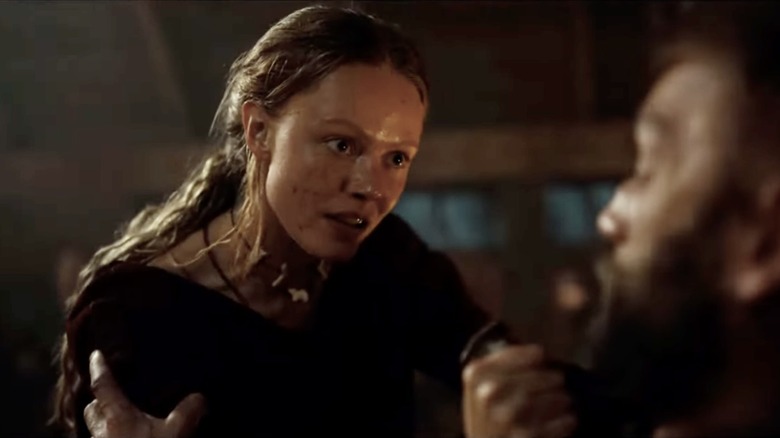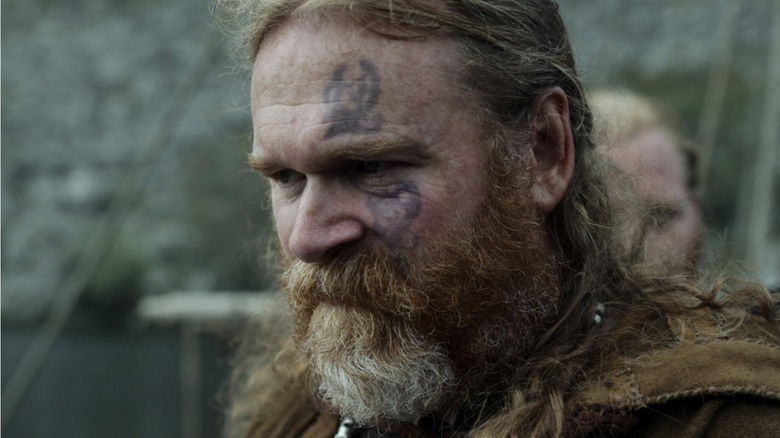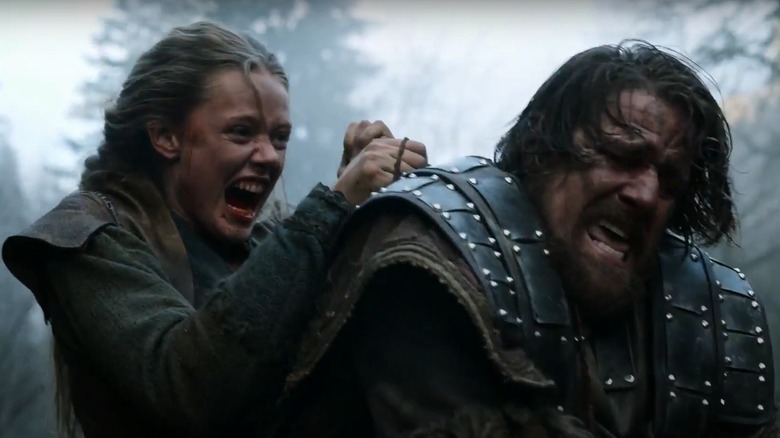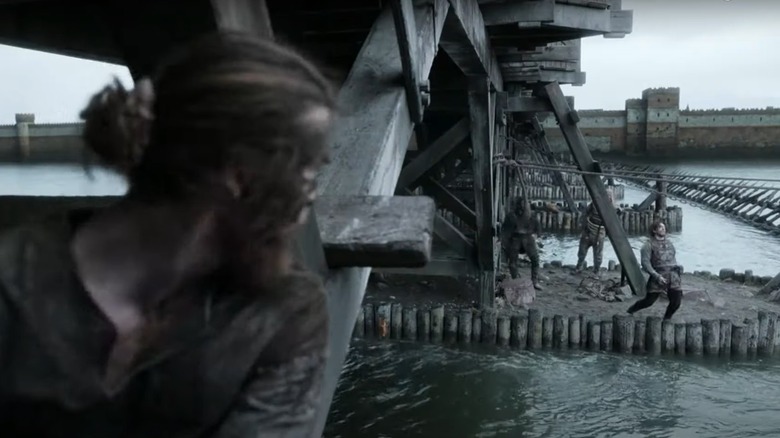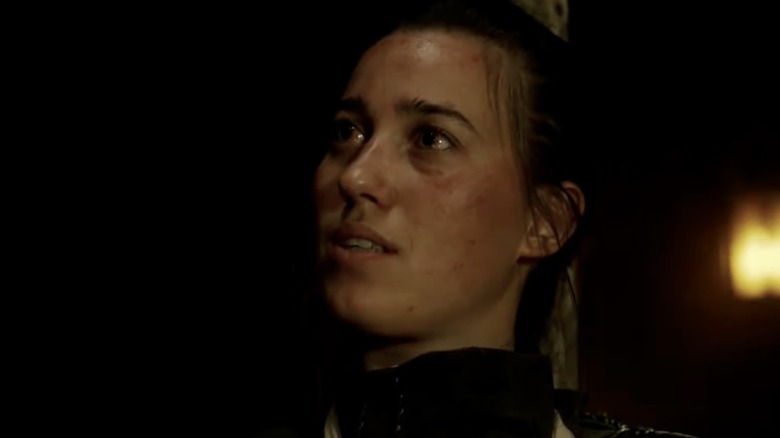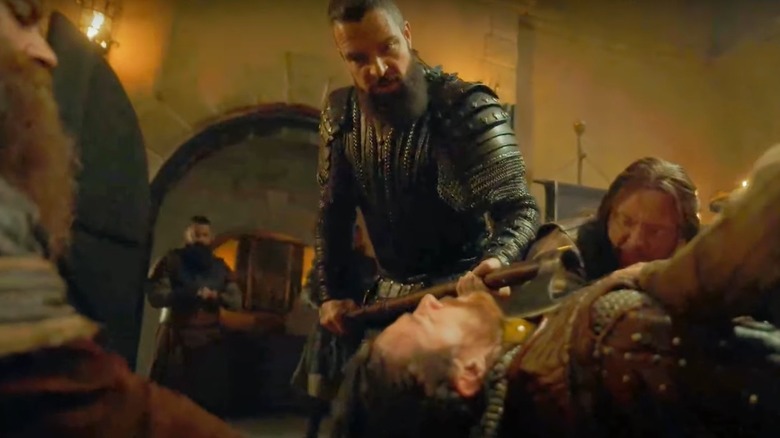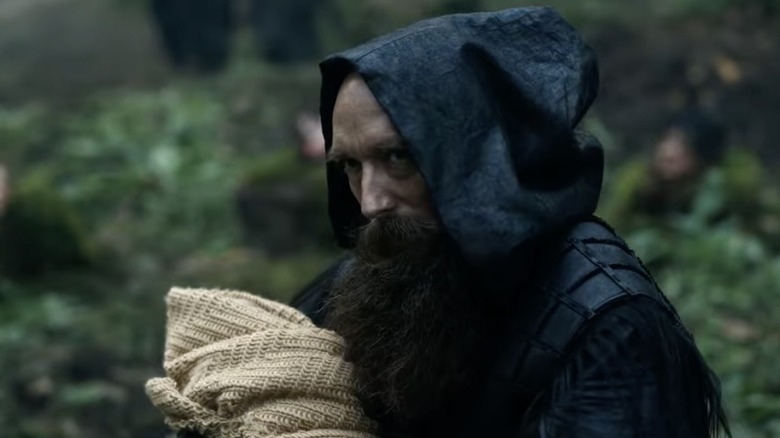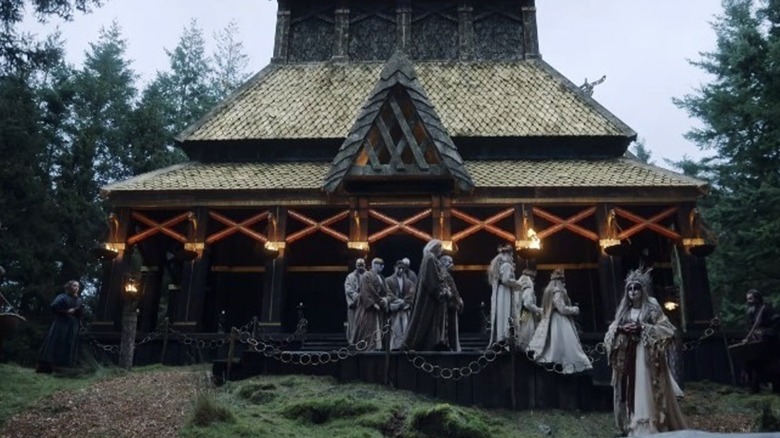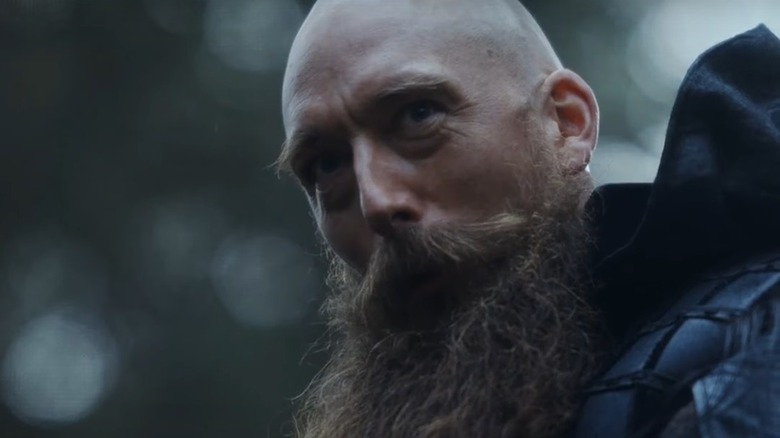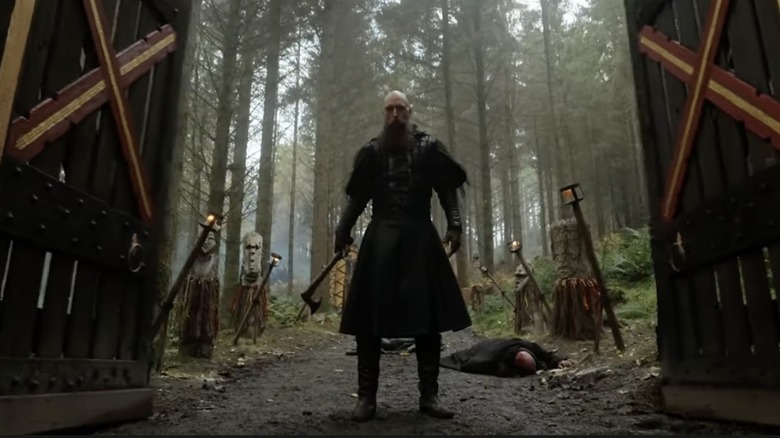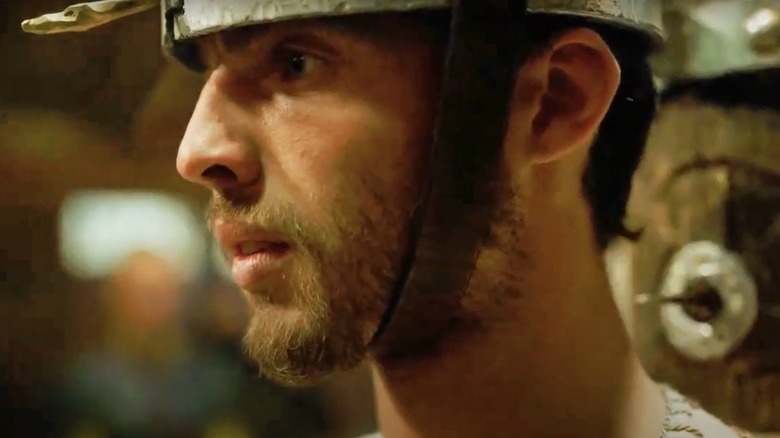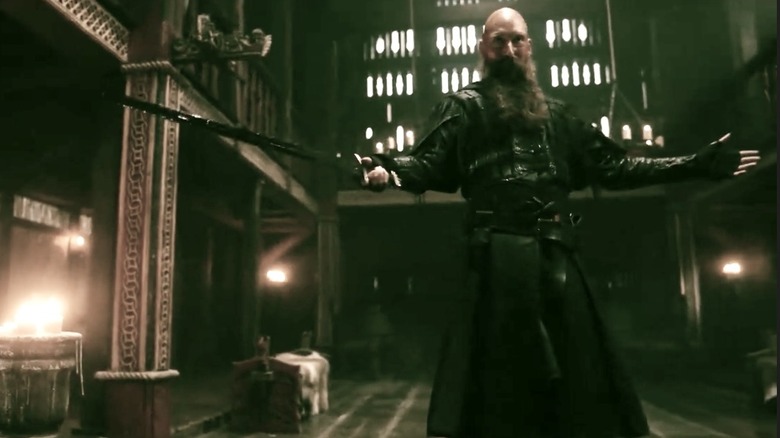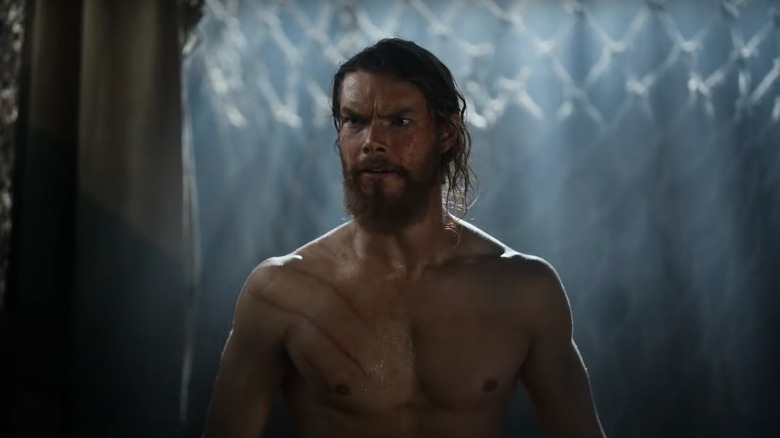Vikings: Valhalla Scenes That Went Too Far
Netflix's follow-up series "Vikings: Valhalla" is an immersive historical epic, picking up 100 years after the original "Vikings" series ended. This period of Viking history, starting in 1002, is fraught with conflict. There is internal political turmoil, external threats from the Saxons in England, and a growing religious conflict between Pagan and Christian Vikings.
We meet some of Scandinavia's most historically significant people in Season 1: The explorer Leif Eriksson and his sister Freydis, the notorious ruler Harald Sigurdsson, the legendary King Canute, and the formidable Queen Emma of Normandy. Drama ensues when they all collide, though creator Jeb Stuart tried to make the story as historically accurate as possible without sacrificing the entertainment value of the series.
If you've seen History's "Vikings," you won't be surprised by the amount of brutality in the Netflix spin-off, which more than matches up to the original in terms of violence. We have abundant beheadings, acts of vengeance, and betrayal, but there are also scenes that pull at the heartstrings and twist your guts. Here are the scenes in "Vikings: Valhalla" that went too far.
Warning: Spoilers ahead!
The St. Brice's Day Massacre
In November of 1002, King Aethelred of England ordered the purging of all Viking settlements in his kingdom, a decision that led to a massive war. Historians are unsure how many Vikings perished during the St. Brice's Day Massacre, but they know that it wasn't just Viking warriors who got targeted that day: Gunhilde, the sister of the Danish king Sweyn Forkbeard, is said to have been killed.
The fictionalized version of this historical event, depicted in Episode 1 of "Vikings: Valhalla," is especially upsetting because we see the inhabitants of Danelaw celebrating together just before their Viking warriors are called away to meet with the king. Of course, the meeting is just an excuse to get the best warriors out of the way, leaving the settlements helpless.
King Aethelred's army slaughtering all those defenseless Danes as they celebrated isn't the only reason the opening scene of the series is so difficult to stomach. It's the cold and calculating way Aethelred deals with the Viking warriors who answered his call that makes it particularly chilling — he invites them to feast with him before his men rain arrows down from above, murdering every last one of them.
Freydis carves a cross into the chest of a Christian Viking
In Episode 1 of "Vikings: Valhalla" we meet Freydis Eriksdotter (Frida Gustavsson), who has traveled from Greenland to Kattegat with her brother Leif Eriksson (Sam Corlett) and their friends. She's seeking vengeance against a man who sexually assaulted and maimed her. We learn about her history as she tells Harald Sigurdsson how she came to have a scar in the shape of a cross on her back: The Christian Viking who assaulted her said he was converting her from her Pagan faith by marking her with the cross.
When Freydis shares this story with Harald, we as viewers understand why she has traveled so far. We also understand that, despite what has happened to her, Freydis is far from broken. She is ready and willing to dish out her own justice, as we see at the end of Episode 1 when she comes face to face with the man who assaulted and scarred her.
It turns out he's an important man with ties to Olaf Haraldsson (Jóhannes Haukur Jóhannesson), but that means nothing to Freydis. To the shock of everyone in Kattegat's Great Hall, the Greenlander appears from nowhere, plunges a knife into the chest of her abuser, and proceeds to carve a cross into it. It's a shockingly gruesome act of vengeance that shapes the course of the entire series.
If you or anyone you know has been a victim of sexual assault, help is available. Visit the Rape, Abuse & Incest National Network website or contact RAINN's National Helpline at 1-800-656-HOPE (4673).
Leif kills a Pagan on his boat
One aspect of Viking culture that "Vikings: Valhalla" focuses on is how divided they became over religion, highlighting the animosity between Pagan and Christian Vikings. When the Vikings gather in Kattegat to plan an invasion of England in response to the St. Brice's Day Massacre, many Pagan and Christian Vikings are opposed to fighting alongside the other in battle. Both groups want revenge for those who perished during Aethelred's brutal slaughter across the sea, but there's no trust between them.
An agreement is eventually hammered out, but the tension is still there as they all set off for England. It comes to a head on Leif Eriksson's boat, where a mixed crew of Pagan and Christian Vikings can't stop bickering. Blood is spilled when a Pagan takes offense to a comment and buries his ax in the neck of a Christian crewmate. That's shocking enough, but what nobody expected was for Leif to dish out hard justice.
Being a Greenlander, Leif is also a Pagan, so you might assume he would side with the killer. He's also an honorable man, and he wasn't about to let that kind of behavior slide on his boat. To make things right, Leif takes the life of the murderer in an equally cold-blooded fashion. This scene perfectly depicts the brutality of the period and the utter disregard for human life some of these warriors expressed.
The berserker attack was particularly brutal
When Leif goes to England to fight for Freydis' freedom, she is left in Kattegat under the watchful eye of its leader, Jarl Estrid Haakon (Caroline Henderson). Freydis is pleasantly surprised to learn she isn't a prisoner when Haakon suggests that she visit the Pagan temple in Uppsala. Freydis sets out with a group of companions from Greenland and guards from Kattegat, only to be attacked by a berserker as they rest beside a river along the road to Uppsala.
The berserker is a Christian mercenary looking for Pagans traveling to the temple. He callously kills all but two of their party, seriously injuring Freydis' friend Yrsa (Álfrún Laufeyjardóttir) before Freydis strangles him on the banks of the river. This mercenary is relentless, strong, and lethal. Freydis only barely survives, cleverly wrapping a piece of string from some jewelry around his throat and choking the life out of him.
The scene highlights how dangerous it was to travel at the time, and it also depicts the extreme animosity Pagan and Christian Vikings felt toward each other. It's especially brutal because the panic and fear Freydis and her companions experience when this hulking stranger attacks them is palpable. The sequence is so well-made that it feels like you went through the ordeal with Freydis.
Leif's friends die carrying out his plan
Leif Eriksson is the Viking explorer thought by historians to be the first European to set foot in North America (per History). In "Vikings: Valhalla," we meet Leif before he finds the New World, when he is just a young man trying to help his sister get justice. Leif joins the Viking assault against England to gain his sister's freedom after her murder of the man who abused her, and he quickly becomes instrumental in the war effort. It is Leif who plans the attack on London Bridge after realizing the drawbridge is a weak point in the structure.
Leif, Harald Sigurdsson, and Leif's friends from Greenland row under the bridge during the cover of night, cutting away at the support beams under the bridge. When the English archers spot them during the battle, Leif's close friends quickly fall under an onslaught of arrows. As Leif uses a hatchet to hack away at the stubborn support beams, he helplessly watches his friends fall to their deaths, hitting the water one by one. Battles guarantee casualties, but the pain Leif exhibits watching his friends die while carrying out his grand plan is emotionally charged. The scene feels like a punch to the heart.
Leif pulling the arrow out of Liv's shoulder
The day after the attack on London Bridge, Leif finds fellow Greenlander Liv among the injured troops. She somehow survived the archers and did not drown, but she has an arrow lodged in her shoulder. Leif's relief to discover one of his friends has survived the battle is quickly eclipsed by his concern that she will not survive her injuries. The situation becomes worse when Leif takes her to the field hospital.
Leif is told that Liv is too weak to survive having the arrow removed and that they cannot waste their time on her. They must instead focus their efforts on those who have a chance of surviving. Leif, knowing just how much of a fighter the girl from Greenland is, doesn't accept their diagnosis. He takes it upon himself to pull the arrow from her shoulder and tend to her wounds himself. This is a very realistic representation of the dangers of injury in a time before modern medicine, and Leif pulling the arrow from Liv's shoulder appears to be excruciating. This scene is definitely not for the squeamish.
King Canute beheads the Ealdorman of Mercia
Once the Viking army has taken down London Bridge, cutting King Edmund (Louis Davison) off from his city, they take the young ruler into custody. King Canute (Bradley Freegard), the Dane who has led the war effort, announces that he intends to stay in England and rule alongside Edmund. During the celebration feast, Canute thanks Eadric Streona (Gavin Drea), the Ealdorman of Mercia, for withdrawing his troops. If the Mercian army had attacked the Viking army as Streona had promised King Edmund, the outcome would have been very different. Canute continues thanking everyone for the roles they played in the battle and speaking well of Queen Emma.
During this scene, it becomes clear that Canute is a different breed of Viking king. He understands the value of loyalty and the necessity of alliances. He seems firm but fair, though when he announces they have a traitor in their midst, the mood quickly shifts. A stump gets rolled into the hall, and Canute unceremoniously beheads the Ealdorman of Mercia for his betrayal of King Edmund. His execution of a man whose actions actually benefited the Viking army is a statement that Canute will not tolerate traitors of any kind. It's an intense scene that's hard to watch, even if Streona had it coming.
Freydis finds the remains of a slaughtered village
Freydis left her friend Yrsa in the care of a medicine woman when they escaped the berserker. After she visited Uppsala, Freydis returned and found her friend strung from the ceiling of the woman's hut. She also discovered the decapitated heads of the remaining villagers strewn around a grove in the forest nearby. Jarl Kåre (Asbjørn Krogh Nissen) and his Christian warriors, who slaughtered the villagers, were still on the scene, waiting for Freydis to show up. They outnumbered her greatly, but they didn't attack.
Freydis finding her friend dead and strung from the ceiling is gruesome enough, but discovering the decapitated heads of the remaining villagers brings this disturbing scene to an entirely different level. This scene is a disturbing depiction of the religious hatred brewing in Scandinavia at the time, with Jarl Kåre and his mercenaries determined to kill off Pagans rather than trying to convert them. Seeing this violence makes you wonder why Kåre hates Pagans so much. What drove him to such brutality?
Jarl Kåre sees his brother being sacrificed
We soon learn that Jarl Kåre was once a Pagan. As a child, he visited the temple of Uppsala with his family and he was traumatized when he witnessed the ritual sacrifice of his brother to the Norse gods. Seeing his brother killed by the priests planted a seed of hatred in Jarl Kåre's heart for the Pagan gods and the people who worship them. The mixture of horror, fear, and anger on the young Kåre's face as his brother's throat is cut before his very eyes is awful to see, despite the monster he becomes. The fact that his parents are watching on as willing participants makes it all the more shocking.
The scene explains why Kåre has a deep and unyielding hatred for Pagans and their gods. It's easy to see him as a murderous madman, but this horrific backstory humanizes him to a certain extent, giving us a front row seat to the grisly Pagan practices of the time. It hardened his heart to all things Pagan, turning him into a religious extremist and a killer. Human sacrifice is unfathomable, horrific, and way too much for most viewers to sit through comfortably. Add a child into the mix, and you're guaranteed to get a strong reaction.
The ship of the dead arrives in Kattegat
After Leif Eriksson, the recovered Liv, and Harald Sigurdsson have returned with the triumphant Viking army from England, Jarl Kåre sends a ship filled with the dead to the port of Kattegat. As this ship drifts through the mist, we can see a body is crucified on the mast, and heads on spikes leer through the fog. The wailing of a baby carries to the shore. The scene is haunting and gruesome to the extreme. When the boat is brought ashore, Freydis announces that she knows the baby from the village near Uppsala.
Of course, this boat of the dead is a message for the people of Kattegat, where religious freedom is practised. Kåre is declaring war on Pagans, and this is a promise of more violence to come. The spooky ship leads the ruler of Kattegat, Jarl Haakon, to send Freydis back to the temple in Uppsala to see what has happened to the people who were not on the boat. There are a lot of decapitations in this series, but this is probably the most visually horrific depiction of death in Season 1.
Aftermath of the massacre at Uppsala
When Freydis, Leif, Liv and Harald arrive in Uppsala, they find it in ruin. Bodies are everywhere, and crows pick at the corpses. As Freydis and Liv walk through the remains of the grand Pagan temple, it is obvious how emotionally wrecked Freydis is by seeing the place she just visited utterly destroyed. The loss of life and the destruction of a sacred place aren't the only things about this scene that are hard to take. When Harald tells Leif that Kåre is "rubbing away all signs of our Pagan past like a stain," it is absolutely chilling.
This is the second mass murder scene in Season 1, and it's every bit as shocking as the St. Brice's Day Massacre. The killing is so widespread that just three children are left alive, and that's only because the Christians wanted them to send a message to Freydis: "He said that his God has ordered him to destroy Kattegat and to kill you." The massacre at Uppsala is a horrible vision of death and destruction, and it sets the stage for a memorable showdown between Freydis and Kåre.
The ritual human sacrifice to Odin
Before the battle with the Christian army, the leader of Kattegat, Jarl Haakon, asks for someone to travel to Asgard to deliver a message to Odin. A young man steps out of the crowd, offering himself up as a willing sacrifice. The concept of human sacrifice is unsavory for most viewers. We can see that this is not something that rests easy with Leif either, despite his sister Freydis embracing this aspect of their Pagan traditions. If this scene is anything to go by, Leif will face a crisis of faith somewhere down the line.
Audun (Adam John Richardson) gets treated with respect and reverence for his bravery and personal sacrifice, but that just seems to make things even creepier. The device they use to paralyze him (which involves a big spike going into the base of his neck) will give you nightmares. This is definitely a scene you can't unsee. Having already pushed past the comfort zone of most viewers, it goes even further when the priest drinks Audun's blood as a tribute to Odin.
Freydis and Jarl Kåre fight to the death
After Kattegat has been sacked and the brave Jarl Haakon is killed, Freydis and Jarl Kåre have their inevitable showdown. It's a memorable battle, one that swings back and forth between the two warriors. At first, Freydis appears to be out of her depth. But, true to her character, she keeps fighting, even after Kåre has disarmed her. As Kåre prepares to kill her with the sword she obtained from Uppsala, Freydis stabs him in the stomach with a hidden knife and hits him with a truth bomb. "The cross that carries the sword was never you," she tells him. "It was my destiny."
Kåre had long believed that he was the subject of a prophecy made by the priests at Uppsala, and learning in his dying moments that this was untrue was the ultimate humiliation for him. After he drops to his knees, Freydis retrieves her sword and decapitates Kåre, bringing a bloody end to their battle. Considering how many people died at Kåre's hands in the same manner throughout Season 1, it's a fitting end for the Christian zealot, but it's still gruesome to behold.
Leif goes all berserker after Liv dies
In Season 1 of "Vikings: Valhalla" we meet three men who are living in the shadows of their powerful fathers: King Edmund, King Canute, and Leif Eriksson, whose dad is the infamous berserker and explorer Erik the Red. At multiple points during Season 1, Leif must defend himself against people who want him dead because his father killed their relatives. Leif repeatedly says he is not his father, but he takes after him in that he is a skilled fighter.
Although Erik the Red is widely recognized for his prowess as a warrior, he has a bad reputation, having been banished from Norway for murder when Leif was a boy. He was later kicked out of Iceland for the same crime. Needing a new home, Erik led a voyage to Greenland, founding the settlement where Leif and Freydis were raised. He ruled it through fear and intimidation, Leif admits during a chat with Liv.
It's obvious that Leif wants to get out of his father's dark shadow, and that he doesn't want to be like Erik the Red. However, when Liv is killed in the Battle for Kattegat, Leif goes full berserker, killing multiple men in a blind rage. The last time we see him in Season 1, Leif is drenched in the blood of his victims, letting out a primal scream. This scene is hard to watch because we know this is Leif's worst nightmare, and we have come to like and respect him.
